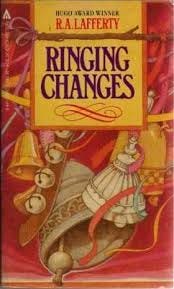"Old Halloweens on the Guna Slopes" (1975) by R. A. Lafferty
Ringing Changes (1984) by R. A. Lafferty
Readers unfamiliar with "Old Halloweens on the Guna Slopes" (1975) by R. A. Lafferty may prefer to read these notes only after reading the story.
"Old Halloweens on the Guna Slopes" is a droll posthumous fantasy. Half a dozen spooks spend Halloween evening reminiscing about wilding nights as human youths making "mischief."
It's a charming and smartly written story. Lafferty immediately throws the reader into the mix of these characters and their dialogue: cross-talk usually at cross-purposes. Lafferty's skill is not, however, in frustrating readers; it rests, like the best Wodehouse stories, in allowing the reader to relax into a mood of delighted expectancy.
“No, they don’t make them like they used to,” Barnaby said. “I remember one Halloween when the old Orcutt streetcar still ran down St. Louis Street. It ended at Orcutt Park on the lake, and there was a turnaround there. One of the car-men lived in a shanty in the park. He would drive the last run at night and the first run in the morning, and he would leave the streetcar all night on the turnaround.”
Austro was doing his weekly Rocky McCrocky comic strip episode with hammer and chisel on light gray slate stone. He filled the incisions with black pigment or graphite, and clear and striking pictures were the result. He would split the light gray slate stone very thin as he finished each panel, and it made almost perfect episode pictures. It was in such form that Austro gave the continuing Rocky McCrocky drama to the young people of the neighborhood and of the world.
“On this side of the park, before you got to the turnaround, there were some stately mansions on the lake shore,” Barnaby continued with his story. “One of the most stately belonged to the Dumbarton family. Mr. Dumbarton was from France. He was a millionaire. He owned one of the refineries out by Sand Springs. But he was a swishy dude. My own father used to say that about him. So we’d fix that swishy dude!
“We had a couple of frogs, those iron rail-clamps made to switch cars from one track to another where there isn’t a regular switching place. We picked a high place about a hundred feet from the turnaround, and we fastened the frogs to the track there. Then we went to the streetcar, put the trolley up to the trolley-wire, got in the car and started it up. We got up all the speed we could going up the rise. We hit the frogs and we derailed, and we went downhill on that new pavement that they had there. We had it all figured perfectly. We even had measured that concrete ramp going up to the Dumbarton front porch, the one they made for Mr. Dumbarton’s grandmother to go up in her wheelchair on. It was wider than it needed to be for a wheelchair to go on. It was just exactly wide enough for a streetcar to go on if we hit it just right.”
Below and outside a monkey howled and sobbed in withering agony and resounded its degradation in the hellish jungle. (There was not, in actual fact, any hellish jungle down there, though the yard between Sheen’s where we were and Benedetti’s was pretty shaggy.) The monkey gave its wrenching howling and sobbing in the terrifying outdoors, and also in the terrifying personal interiors. It may have been a ghost monkey.
“Monkeys had Halloween before people did,” Austro said. “Really, that’s true. If they didn’t kill so many of each other on every Halloween, the world would be overrun with them now.”
“We rolled down that hill faster and faster,” Barnaby was recounting, “and we stomped on that trolley bell. Clang! Clang! Oh, I wish they still made trolley bells like that! There wasn’t any way to steer that streetcar when it wasn’t on tracks, but it steered itself. The street turned sharply there, but the driveway of the Dumbartons was in a straight line. We went up that driveway with the sparks flying from the iron wheels on the concrete, up the ramp onto the front porch or veranda, down the whole length of the porch—Clang! Clang! Clang!— and clear through a wall at the end.
“And through the wall was the master chamber of the Dumbartons’ house. The master chamber was probably the biggest bedroom in town, but it was a little bit crowded with a full-size streetcar right in the middle of it. And we kept clanging that trolley bell. A trolley bell sounds quite a bit louder when the streetcar is inside a bedroom.
"‘Sancta Agatha!’ Mrs. Dumbarton cried out in her fine voice as she sat up in bed.
“'Ora pro nobis!’ Mr. Dumbarton cried out in an even finer voice, and he sat up in bed too. And Clang! Clang! Clang! went that trolley bell. John Penandrew was the boy stomping on the bell. The Dumbartons, waking up like that, thought that the trolley bell was a church bell back in France.
“They begin to ring the church bells at midnight there, when Halloween is over with and All Saints’ Day begins. And they begin to chant that Litany of the Saints. You know, though, that swishy dude Dumbarton caught on real fast. 1 never saw a man comprehend a streetcar in the middle of his bedroom so fast. And I never saw a two-handed creature collar six kids as quick as he did it. And he seemed to have hands left over to—-”
“Ah, they don’t make Halloweens like that anymore!” we all breathed together.
R. A. Lafferty was not a writer for every mood or every day. But as the creator of "Old Halloweens on the Guna Slopes," he made something very special.
Jay






